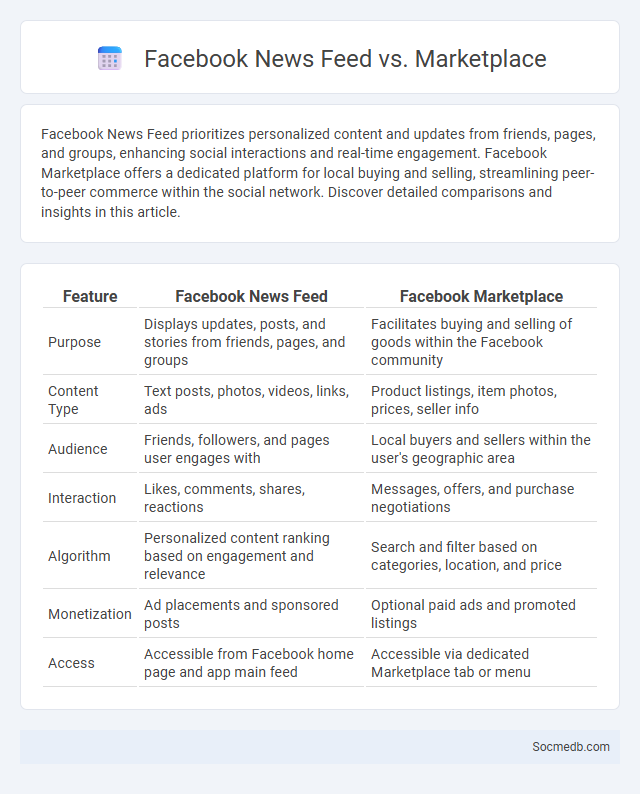
Photo illustration: Facebook News Feed vs Marketplace
Facebook News Feed prioritizes personalized content and updates from friends, pages, and groups, enhancing social interactions and real-time engagement. Facebook Marketplace offers a dedicated platform for local buying and selling, streamlining peer-to-peer commerce within the social network. Discover detailed comparisons and insights in this article.
Table of Comparison
| Feature | Facebook News Feed | Facebook Marketplace |
|---|---|---|
| Purpose | Displays updates, posts, and stories from friends, pages, and groups | Facilitates buying and selling of goods within the Facebook community |
| Content Type | Text posts, photos, videos, links, ads | Product listings, item photos, prices, seller info |
| Audience | Friends, followers, and pages user engages with | Local buyers and sellers within the user's geographic area |
| Interaction | Likes, comments, shares, reactions | Messages, offers, and purchase negotiations |
| Algorithm | Personalized content ranking based on engagement and relevance | Search and filter based on categories, location, and price |
| Monetization | Ad placements and sponsored posts | Optional paid ads and promoted listings |
| Access | Accessible from Facebook home page and app main feed | Accessible via dedicated Marketplace tab or menu |
Overview of Facebook News Feed and Marketplace
Facebook News Feed curates a personalized stream of posts, updates, and shared content from friends, pages, and groups, utilizing advanced algorithms to prioritize relevance and engagement. The Facebook Marketplace offers a localized platform for buying and selling goods, connecting you with nearby buyers and sellers through user-generated listings. Both features leverage data-driven insights to enhance user interaction and commerce within the Facebook ecosystem.
Key Differences Between News Feed and Marketplace
News Feed primarily functions as a dynamic stream where You can view updates, posts, and multimedia content from friends, pages, and groups, designed for social engagement and information sharing. Marketplace serves as a dedicated platform within social media for buying, selling, and discovering local products, emphasizing transactional interactions over social connections. Understanding these key differences helps You optimize your use of social media for both community engagement and commercial opportunities.
User Experience: Browsing vs Shopping
Social media platforms optimize user experience by balancing seamless browsing with efficient shopping features, allowing you to easily discover content while making purchases without leaving the app. Interactive elements like personalized recommendations, shoppable posts, and integrated payment options enhance convenience and engagement. This blend of browsing and shopping creates a fluid journey, encouraging longer user sessions and higher conversion rates.
Content Types: Social Updates vs Product Listings
Social media content types significantly impact engagement, with social updates fostering community interaction through personalized stories, behind-the-scenes looks, and user-generated content, while product listings drive direct sales by showcasing features, pricing, and promotions. Your strategy should balance authentic social updates to build brand loyalty and trust, alongside clear, concise product listings that guide followers toward conversions. Leveraging analytics on post performance can optimize the mix of content types to maximize reach and ROI.
Audience Targeting and Reach
Social media platforms utilize advanced audience targeting techniques, including demographic, behavioral, and interest-based data, to precisely reach relevant users. Leveraging tools such as lookalike audiences and retargeting campaigns enhances engagement by presenting content to high-potential consumers. Optimized targeting combined with expansive reach maximizes brand visibility and improves conversion rates.
Advertising Opportunities on News Feed and Marketplace
Social media platforms offer extensive advertising opportunities on their News Feed and Marketplace sections, enabling brands to reach highly targeted audiences through personalized ad placements. News Feed ads benefit from high visibility and engagement rates by appearing directly within users' content streams, utilizing advanced algorithms to optimize viewer relevance. Marketplace advertising allows businesses to promote products in a context-driven shopping environment, leveraging user intent and local targeting to drive conversions effectively.
Impact on Businesses and Brands
Social media platforms significantly enhance brand visibility and customer engagement by enabling real-time interactions and personalized marketing campaigns. Analytics tools integrated within these platforms provide businesses with valuable insights into consumer behavior and market trends, facilitating data-driven decision-making. Effective social media strategies contribute to increased brand loyalty, lead generation, and overall revenue growth for companies across various industries.
Privacy and Security Concerns
Social media platforms collect vast amounts of personal data, making your privacy vulnerable to breaches and unauthorized access. Security concerns include data mining, targeted advertising, and potential identity theft, putting your sensitive information at risk. Implementing strong passwords, privacy settings, and cautious sharing practices can significantly enhance your protection against these threats.
User Engagement and Interaction Patterns
User engagement on social media platforms is driven by interactive content such as polls, stories, and live videos, which foster real-time communication and build community. Analyzing interaction patterns like comment frequency, share rates, and click-through ratios helps optimize content strategies tailored to your audience's preferences. High engagement metrics signal strong connection and relevancy, boosting algorithmic visibility and enhancing overall digital presence.
Future Trends: Evolution of Facebook Features
Facebook is integrating advanced AI-driven personalization to enhance user engagement and content relevance, leveraging machine learning algorithms for real-time sentiment analysis and adaptive news feeds. The platform is expanding augmented reality (AR) capabilities with immersive social experiences, including virtual reality (VR) meeting spaces and AR shopping features. Enhanced privacy controls and blockchain-based data security measures are being implemented to address growing concerns over data protection and user trust.
 socmedb.com
socmedb.com